
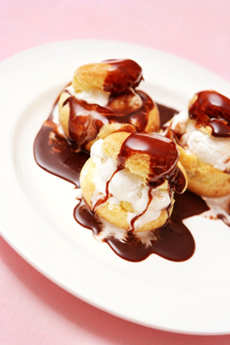 Profiteroles: cream puff pastry stuffed with ice cream. Photo by Kevin Russ | IST. Profiteroles: cream puff pastry stuffed with ice cream. Photo by Kevin Russ | IST.
July 2005
Last Updated November 2025
|
 |
Different Ice Cream Types
Ice Cream Glossary Page 4: Terms & Definitions: K ~ Q
This is Page 4 of a five-page glossary covering the different ice cream types. This page explains the different types of standard ice cream. It also contains terms such as kulfi, Philadelphia ice cream, and profiteroles. See our many other food glossaries.
Click on a letter of the alphabet to go to the appropriate glossary section:
a b c d e f g h i j k l m n o p q r s t u v w x y z
This material is copyrighted and cannot be reproduced in whole or in part
without written permission. You are welcome to link to it.
KANAZAWA ICE
See Non-Melting Ice Cream, below.
|
KEFIR (FROZEN)
Made from the drink kefir, frozen kefir is related to frozen yogurt. It looks and tastes like yogurt, but has a different complement of microorganisms. The result: A food even more healthful than probiotic yogurt. It’s a boon to the lactose intolerant as well: Lifeway Frozen Kefir, a leading brand, is 99% lactose-free. Read our full review of this frozen delight.
|
|
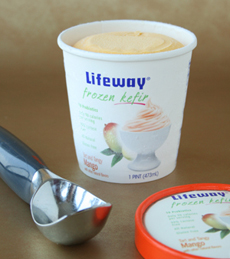
Frozen kefir is similar to frozen yogurt, but is 99% lactose-free with more probiotics. Photo by River Soma | THE NIBBLE.
|
|
KLONDIKE BAR
Hot on the heels of the Eskimo Pie, the Klondike Bar was launched by the Isaly Dairy Company of Youngstown, Ohio, around 1922. It was named after the Klondike region of Canada, made famous by the Klondike Gold Rush of the late 19th century. The original product was a square slab of vanilla ice cream coated in a thin, hardened chocolate shell, wrapped in silver foil. Today there are varieties that range from Original to Cookies and Creme, Dark Chocolate, Double Chocolate, Heath Bar, Krunch, Mint Chocolate Chip, No Sugar Added Krunch, No Sugar Added Vanilla, and Reese’s.
|
|
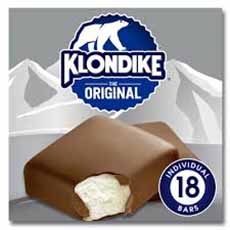
The Klondike Bar, initially just vanilla ice cream, now has numerous flavors (photo © Unilever).
|
KNICKERBOCKER GLORY
A Knickerbocker Glory is a sundae that appeared in the U.K. in the 1920s. It is attributed to a Mr. J. Crouch of Sherston, Wiltshire, England. Built in a tall sundae glass, it originally layered ice cream with whipped cream, fruit, and gelatin: what is called a parfait in America. It is designed to have horizontal red and white “stripes” which give it its name. Red and white hosiery called knickerbockers (think striped knee socks, Raggedy Ann and Pippi Longstocking) were popular with schoolgirls of the time. The sundae was served with a long spoon to get to the bottom. To be a Knickerbocker Glory, the dish must maintain the red and white stripes; anything else is a tall sundae. However, additional ingredients can be added: Syrups, nuts, a cherry on top, and a cookie garnish are popular.
|
|
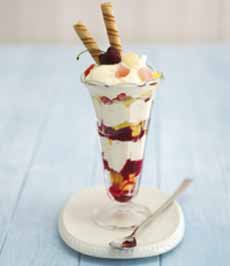
Knickerbocker Glory is a sundae from the 1920s-era U.K. It’s a parfait designed to have red and white stripes. Photo Pinterest.
|
|
KULFI
A dense Indian-style ice cream made with water buffalo’s milk and flavorings like cardamom, chikoo (the Mexican fruit known as sapote), coconut, malai (almond), mango, pistachio, and saffron. Kulfi sold in the U.S. is generally made with cow’s milk. Unlike Western ice creams that are whipped with air, kulfi contains no air (overrun)—it is solid, dense frozen milk. As such, it is not ice cream, but a different category of frozen, dairy-based dessert. Kulfi is also never made with eggs, like French ice cream. It is prepared by simply boiling milk until it is reduced to half; then sugar and a teaspoon of corn syrup are added, and the mixture is boiled for 10 more minutes. Water is mixed in until it thickens into a paste and is boiled for a while longer. Finally, flavorings, dried fruits, or cardamom are added. The mixture is cooled, put into molds, and frozen. Kulfi can be presented very elegantly or casually, as in the kulfi ice cream bar at the right. Kulfi is believed to have originated in Persia and was introduced to the Indian subcontinent by Mogul royals in the 1500s.
|
|
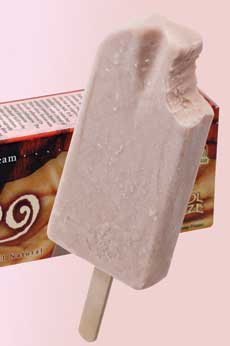
A kulfi ice cream bar in chikoo (sapote) from Kool Freeze. Read our review. |
|
MALTED MILK
A malted milk—“malt” for short—is a milkshake to which malt powder has been added. Malt powder is a mixture of malted barley, wheat flour, and whole milk, which is evaporated into a powder. Originally a health food for infants and invalids, it found a new market when Americans began drinking Horlick’s malted milk for the great taste. It became a standard offering at soda fountains and found permanent popularity when mixed with ice cream in a malted milkshake, or “malt.” It’s also used to make chocolate-covered malted milk balls.
|
|
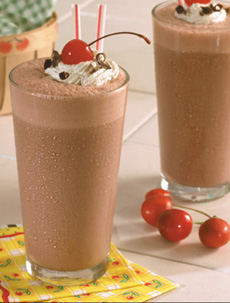
A chocolate malted milk, or chocolate malt. Photo courtesy Cherry Marketing Institute. |
MILKSHAKE
The milkshake began life in the late 1800s as an alcoholic drink (here’s the story). Today, it’s a blended ice cream drink made from ice cream, milk, and a flavored syrup, such as chocolate, coffee, fruit, or vanilla. It can be garnished with whipped cream, more syrup, and a maraschino cherry. Traditionally, milkshakes were made to order, using a milkshake machine with a metal cup. The ice cream was scooped in, milk and syrup added; the cup was inserted under special beaters. Today, many chains have automatic milkshake machines that serve a premade, frozen milkshake mixture.
|
|
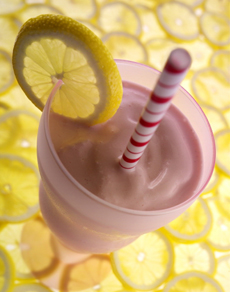
A strawberry milkshake. Photo courtesy Wisconsin Milk Marketing Board. |
|
MOCHI ICE CREAM
Mochi ice cream is a Japanese confection: a shell of mochi (pounded sticky rice) filled with ice cream and dusted with cornstarch. Originally, the small, soft, round balls of dough were a pastry filled with sweetened red bean (adzuki), and are still made with different fillings. As a frozen dessert, there are many flavors, including chocolate, green tea (matcha), red bean, strawberry, and vanilla. Here’s the history of mochi.
|
|
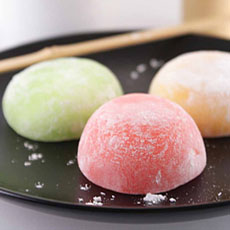
Mochi ice cream. Photo courtesy Asian Grocer. |
|
MONAKA ICE CREAM SANDWICH
For years, monaka has been a popular Japanese dessert (wagashi): crisp wafer cookies sandwiched around red bean (azuki) paste, chestnut paste, sesame, even rice cake (mochi), and jam. The shells can be any shape: not just square, rectangular, or round, but in the shape of fish, flowers, etc. In Japan, monaka is served with tea, like tea cakes in the West. There are very famous specialty stores in Japan. More recently, monaka ice cream sandwiches have become the rage, filled with all flavors of ice cream. As in the photo, there can be an inner layer of jam, bean paste, chocolate, or whatever appeals to the pastry chef. The good news: Monaka ice cream sandwiches have begun to make their way to the U.S.
|
|
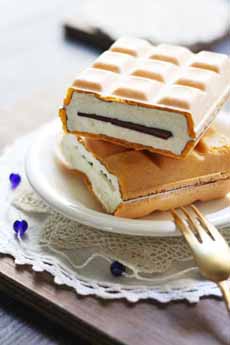
Monaka ice cream sandwich. Photo courtesy Amelbo.jp. |
NON-MELTING ICE CREAM or KANAZAWA ICE
Kanazawa non-melting ice cream, also known as Kanazawa Ice, is a Japanese dessert made by scientists at the Biotherapy Development Research Center in Kanazawa, Japan. Tomihisa Ota, professor emeritus of pharmacy at Kanazawa University, was testing the polyphenol extracts to try and make a strawberry dessert, and accidentally discovered that adding strawberry extract to ice cream prevents it from melting for a significant period. The extract contains polyphenols that bind to the oil and water in the ice cream, making it difficult for water and oil to separate, thus creating a stable structure that slows down the melting process. Reports showed it kept its shape even after five minutes under a hair dryer.
Kanazawa Ice popsicles first hit stores in Kanazawa in April 2017, before rolling out in Osaka and Tokyo, and soft-serve versions went on sale in January 2018. Unfortunately, making the ice pops and soft-serve non-melting also changed the texture, which was not pleasing to consumers, and the product was discontinued. Other scientists are still pursuing the holy grail of ice cream. Here’s more about it.
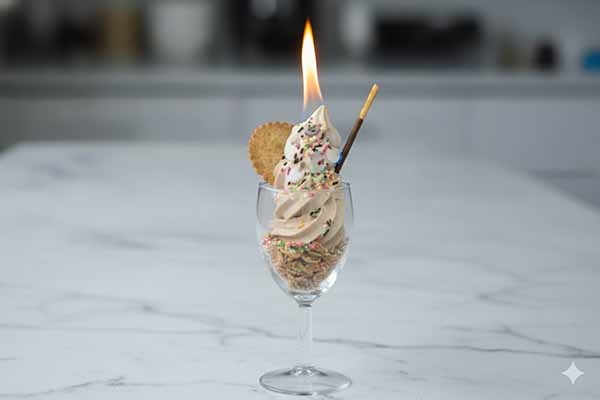
Even a hairdryer didn’t melt it (Gemini Photo).
|
NOVELTY
A single-serving, grab-and-go frozen treat. Examples include ice cream bars, ice cream sandwiches, Drumsticks, ice pops, frozen yogurt bars, mochi ice cream, and character-shaped treats marketed to children.
Bomb Pops, originally called Rocket Pops, are one of the novelties that have their own food holiday: National Bomb Pop Day, celebrated on the last Thursday of June. Here’s the history of Bomb Pops.
Here are all the year’s 50+ ice cream holidays.
OVERRUN
The amount of air churned into an ice cream or gelato during freezing. Super-premium ice creams have less than 50% overrun.
|
|
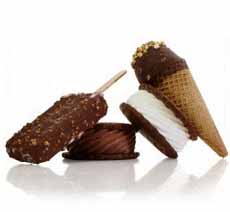
Ice cream novelties. Photo courtesy Gcasd.com.
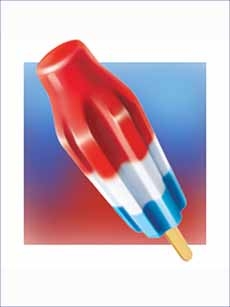
The Bomb Pop (photo © Blue Bunny).
|
|
PARFAIT
Parfait, the French word for perfect, is the original French sundae. It was/is made with a custard base (French) ice cream flavored with fruit purée and whipped with a lot of air to a delicate texture. The ice cream was not scooped but pre-frozen in individual serving containers—typically the long, tapered parfait glasses, narrower versions of sundae dishes. In America, a “parfait” became a particular type of sundae, different from the French parfait.
American Parfait Vs. Sundae
-
An American parfait shows its ingredients in layers: ice cream, syrup, and fruit. It is traditionally served in a tall, narrow, short-stemmed glass and topped with whipped cream.
-
A traditional sundae dish is wider and tulip-shaped, with a scalloped rim. First, ice cream is scooped into the dish, and it is topped with syrups, fruits, wet walnuts, and crowned with whipped cream and a maraschino cherry (today, a fresh strawberry is often substituted). Crushed nuts and sprinkles can also be added.
|
|
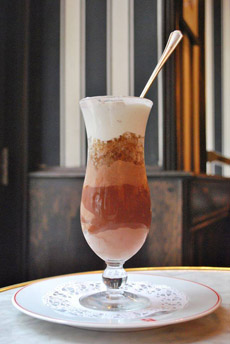
A parfait is a layered sundae, traditionally served in a curved, footed glass. It can be simple, with alternating layers of ice cream and syrup, or a mélange of fruits, cookies, and other ingredients. Photo courtesy Benoit Bistro. |
-
A French parfait differs from the American version. It is a frozen dessert made by folding fruits, nuts, and/or other ingredients into whipped cream or egg custard—more like a semifreddo or frozen soufflé. See the different types of ice cream.
- The history of the parfait.
- The sundae was invented in the U.S. Here’s the history of ice cream.
PHILADELPHIA-STYLE ICE CREAM
Ice cream made without eggs. An egg-custard base is known as French ice cream or French custard ice cream, and is a richer style. Philadelphia-style ice cream is what we know as “regular” ice cream.
|
PROFITEROLES
Profiteroles are pâte à choux, or cream puff pastry, filled with ice cream and generally topped with chocolate sauce. The difference between a cream puff and a profiterole is that cream puffs are filled with custard or whipped cream, and profiteroles are filled with ice cream. Fresh fruit or powdered sugar are alternative toppings, and the puffs can be caramel-glazed, as in croque-en-bouche. Learn how to make pâte à choux.
QUIESCENTLY-FROZEN or STILL
FROZEN
The process of freezing a dessert mixture without churning.
|
|

Profiteroles. Photo by Kevin Russ | IST. |
Continue To The Next Page: Terms With S To Z
Go To The Article Index Above
Lifestyle Direct, Inc. All rights reserved. Images are the copyright of their respective owners.

|
















